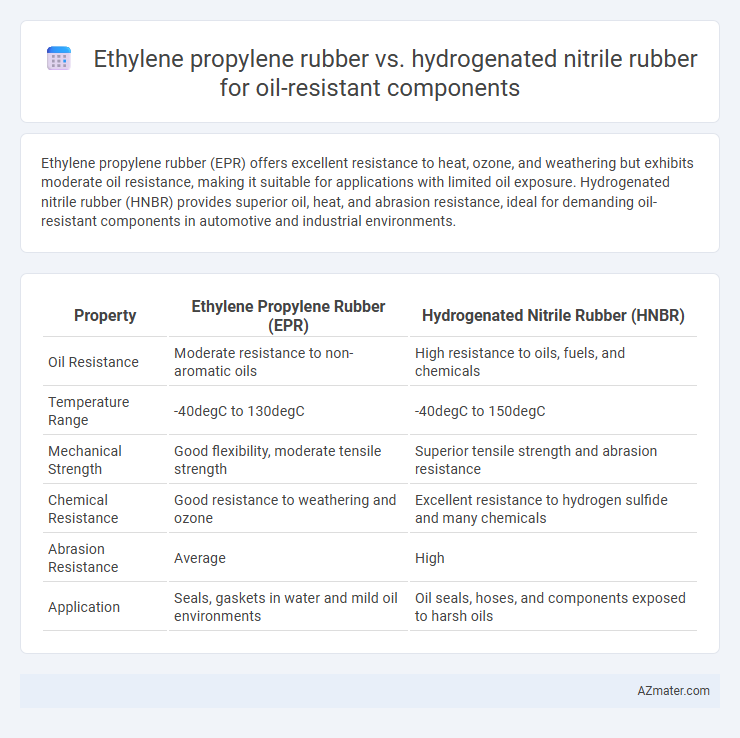Ethylene propylene rubber (EPR) offers excellent resistance to heat, ozone, and weathering but exhibits moderate oil resistance, making it suitable for applications with limited oil exposure. Hydrogenated nitrile rubber (HNBR) provides superior oil, heat, and abrasion resistance, ideal for demanding oil-resistant components in automotive and industrial environments.
Table of Comparison
| Property | Ethylene Propylene Rubber (EPR) | Hydrogenated Nitrile Rubber (HNBR) |
|---|---|---|
| Oil Resistance | Moderate resistance to non-aromatic oils | High resistance to oils, fuels, and chemicals |
| Temperature Range | -40degC to 130degC | -40degC to 150degC |
| Mechanical Strength | Good flexibility, moderate tensile strength | Superior tensile strength and abrasion resistance |
| Chemical Resistance | Good resistance to weathering and ozone | Excellent resistance to hydrogen sulfide and many chemicals |
| Abrasion Resistance | Average | High |
| Application | Seals, gaskets in water and mild oil environments | Oil seals, hoses, and components exposed to harsh oils |
Introduction to Oil-Resistant Elastomers
Ethylene propylene rubber (EPR) and hydrogenated nitrile rubber (HNBR) are prominent oil-resistant elastomers extensively used in automotive and industrial seals. EPR offers excellent resistance to heat, ozone, and aging but has limited oil resistance compared to HNBR, which provides superior resistance to petroleum oils, hydraulic fluids, and oxidation. HNBR's enhanced mechanical properties and chemical stability make it the preferred choice for demanding oil-exposed environments.
Overview of Ethylene Propylene Rubber (EPR/EPM/EPDM)
Ethylene Propylene Rubber (EPR/EPM/EPDM) is a synthetic elastomer known for its excellent resistance to ozone, weathering, and ageing, making it widely used in oil-resistant components subjected to harsh environmental conditions. Its saturated polymer backbone provides superior heat resistance and good flexibility, although it exhibits moderate resistance to petroleum-based oils compared to Hydrogenated Nitrile Rubber (HNBR). EPR's chemical stability and ability to maintain performance across a broad temperature range make it suitable for sealing, hoses, and gaskets in automotive and industrial oil applications where moderate oil resistance is acceptable.
Key Properties of Hydrogenated Nitrile Rubber (HNBR)
Hydrogenated nitrile rubber (HNBR) offers superior oil and chemical resistance compared to ethylene propylene rubber (EPR), making it ideal for oil-resistant components in harsh environments. Key properties of HNBR include excellent thermal stability up to 150degC, enhanced abrasion resistance, and strong mechanical strength, ensuring durability in demanding applications. Its resistance to degradation by oils, fuels, and oxidizing agents outperforms EPR, making HNBR a preferred material for seals, gaskets, and hoses in automotive and industrial oil-related uses.
Chemical Resistance: EPR vs HNBR
Ethylene Propylene Rubber (EPR) exhibits moderate chemical resistance, performing well against acids, alkalis, and oxygenated solvents but showing limited resistance to hydrocarbons and oils. Hydrogenated Nitrile Rubber (HNBR) offers superior chemical resistance, particularly against petroleum-based oils, fuels, and aliphatic hydrocarbons, making it ideal for oil-resistant applications. HNBR's enhanced thermal stability and resistance to swelling in aggressive oil environments outperform EPR in oil sealing and automotive fuel system components.
Oil and Fuel Resistance Comparison
Ethylene propylene rubber (EPR) offers excellent resistance to mineral oils and non-polar solvents but has limited effectiveness against aromatic hydrocarbons found in fuels. Hydrogenated nitrile rubber (HNBR) provides superior oil and fuel resistance, especially against a broad range of automotive fuels, oils, and synthetic lubricants due to its saturated polymer backbone and enhanced chemical stability. For oil-resistant components exposed to aggressive fuels and high temperatures, HNBR outperforms EPR in maintaining mechanical integrity and preventing swelling or degradation.
Temperature Tolerance and Performance
Ethylene propylene rubber (EPR) offers excellent temperature tolerance, typically ranging from -50degC to 150degC, making it suitable for components exposed to moderate heat and weathering, but it has limited resistance to oil and hydrocarbons. Hydrogenated nitrile rubber (HNBR) provides superior oil resistance and higher temperature tolerance, generally between -40degC to 160degC, maintaining performance in harsh environments with exposure to oils, fuels, and chemicals. For oil-resistant components requiring durability at elevated temperatures and aggressive fluid contact, HNBR outperforms EPR in both thermal stability and chemical resilience.
Mechanical Strength and Durability
Ethylene propylene rubber (EPR) exhibits excellent mechanical strength with superior flexibility and resistance to weathering, making it suitable for oil-resistant sealing components subjected to tensile and dynamic stresses. Hydrogenated nitrile rubber (HNBR) offers enhanced durability with exceptional abrasion resistance, chemical stability, and high temperature tolerance, providing longer service life in harsh oil and fuel environments. Selecting HNBR over EPR improves component longevity in aggressive conditions, while EPR is preferable for applications requiring greater elasticity and low-temperature performance.
Cost Analysis: EPR vs HNBR
Ethylene Propylene Rubber (EPR) generally offers a lower cost solution compared to Hydrogenated Nitrile Rubber (HNBR) for oil-resistant components due to its simpler production process and widespread availability. HNBR, while more expensive, provides superior oil, heat, and chemical resistance, which can reduce long-term maintenance and replacement costs in high-performance applications. Cost analysis should weigh the initial material price of EPR against the enhanced durability and extended service life of HNBR in oil-exposed environments.
Typical Applications in Oil-Resistant Components
Ethylene propylene rubber (EPR) exhibits excellent resistance to heat, ozone, and aging, making it suitable for automotive seals, hoses, and gaskets exposed to non-aromatic oils and extreme weather conditions. Hydrogenated nitrile rubber (HNBR) offers superior oil, fuel, and chemical resistance, along with high mechanical strength, which is ideal for dynamic oil-resistant components such as O-rings, seals, and diaphragms used in fuel injection systems and oilfield equipment. The choice between EPR and HNBR depends on the specific exposure to hydrocarbons and the temperature range required for reliable performance in oil-resistant applications.
Choosing the Right Rubber for Oil Exposure
Ethylene propylene rubber (EPR) offers excellent resistance to heat, ozone, and weathering but has limited resistance to petroleum oils, making it less suitable for heavy oil exposure. Hydrogenated nitrile rubber (HNBR) provides superior oil and chemical resistance due to its saturated polymer backbone, making it ideal for high-performance oil-resistant components in automotive and industrial applications. Selecting HNBR ensures enhanced durability and longer service life in environments with continuous exposure to oils and fuels.

Infographic: Ethylene propylene rubber vs Hydrogenated nitrile rubber for Oil-resistant component
 azmater.com
azmater.com